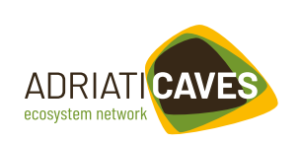In the year we are slowly leaving behind, Lipa cave, much like the rest of the world, has faced many challenges, the major ones definitely being travel and limited movement. Seeing as caves are fragile ecosystems formed and developed in silence and darkness over millions of years, one might find that patience and perseverance are their common features, which is exactly what caves have taught us this year.
Since patience and perseverance advance within a community, forming a network with other caves of the Adriatic region through Adriaticaves project, Lipa cave is both getting and providing support in these challenging times. The main goal of the Adriaticaves project is to establish and promote the natural and archeological heritage of the caves located in the Adriatic region as an all year long tourist offer while forming a platform for sustainable tourism development. Adriaticaves is being developed as a part of a wider Interreg ADRION project that invests in the promotion of cultural exchange, environmental sustainability, and protection of the natural and cultural heritage of the Adriatic-Ionian region.
If patience and perseverance are common cave characteristics, and their peculiarities the things that set them apart, the wealth of the experience they create is practically impossible to describe until you set foot in one of them.
Yet mere knowledge about these fantastic underground worlds is enlightening and inspiring, therefore, we find this current situation as a perfect opportunity to point to the myriad of caves of the region alongside which Lipa cave is maturing.
Majella National Park in Italy is the leading partner of the Adriaticaves project. Located in a vast karst area and known for its abundance of water, this national park is adorned by over 100 caves, most of which are found in the Majella Massif. The caves open for visits are Cavallone Cave, Bove Cave, Praje Cave, and Scura Cave which keeps important prehistoric remains. Tourist offer includes one-day and several-day tours through caves and the surrounding area.
Italian Romagna area is characterized by evaporate rocks formed by gypsum and clay deposits, hence, the abundance of these minerals deeply affected the development of local culture and tradition. While over 250 caves were found and explored in this area only three of them, Re Tiberio, Tanaccia, and Onferno have been adapted for tourist visits. A four-day tour is an opportunity to discover all three of them along with the nature, history, and tradition of this area, and the offer includes a two-day visit to Re Tiberio and Tanaccia caves as well as a one-day tour around Onferno Cave.
The most famous speleological sites in Croatia are Cerovac Caves located within Velebit Nature Park. The complex is comprised of three caves – Lower, Middle, and Upper which extend to a total of 7km long passages. Cerovac Caves are also significant archeological sites and one of the largest cave bear sites in Croatia. Tourists can visit the first 700m of Lower and Upper Caves so they can be explored within a three-hour-long tour. Should you wish to visit Barać Caves and Grabovac Caves and experience the magic of Croatian karst, the offer includes a two-day visit to these localities as well.
Speleological area Bijambare is a protected natural site of Bosnia and Herzegovina located a mere 40km from the capital Sarajevo. The area is covered in woods, small lakes, brooks and springs, and is ideal for an active vacation. The complex includes multiple caves, three of which are available for visits. The most popular is the Middle Bijambare Cave which is over 400m long. You can choose between a daylong or two-day tour around the caves and nearby localities of cultural and historical importance.
At the territory of Serbia between steep slopes of Ovčar and Kablar mountains, there is a gorge formed by the West Morava River. This area, known for the untouched environment and rich cultural and historical heritage, is also known for the caves Kađenica and Turčinovac. The most important feature of Kađenica Cave is the cave church built in the 19th century by the local inhabitants who sought shelter and comfort during wars. Daylong and two-day long tours around this area include a visit to the cave Kađenica and its most important monasteries which leave a near-religious experience. You can also opt for a three-day offer which includes a visit to Turčinovac Cave as well.
Lipa Cave is the first and still the only valorized cave in Montenegro. Ever since its discovery in the early 19th century and over a century and a half afterward, Lipa cave played an important role for local inhabitants, and it was admired by the most prominent rulers of the Petrović-Njegoš dynasty. The visit to Lipa cave is a fantastic addition to the tourist offer of the Old Royal Capital Cetinje, and the proximity of Lovćen Mountain, River Crnojevića, and Lake Skadarsko enables the visitors to have a perfect daylong excursion. A five-day-long offer allows visitors an opportunity to soak in all the wonders of the Bay of Kotor, Cetinje, and their surroundings.
The Albanides represent a portion of the Dinaric Alps extending from Slovenia to Southern Greece, therefore, numerous caves are located in the territory of Albania. During a three-day-long tour, you can visit Dhenve Cave and Moho Cave. A two-day tour around the southern part of the Albanian Alps gives a chance to enjoy the wonders of Perkali Cave, while major beauty of Albanian nature and Arapi Cave can be admired within the four-day visit to this area.
From Albania to Italy, through Montenegro, Serbia, Bosnia and Herzegovina, and Croatia, joined by the Adriatic Sea and the Dinaric Alps, the caves of the region are ready to welcome us. Equipped with patience and basic knowledge about the caves, we as well are ready to visit them, and all that is left to do is to pick the best place to start.
In the meantime explore our website and find out more about Adriaticaves project or download Informative catalogue.



